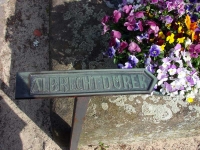The first time I came here, it was winter.
Now at last I have worked out how to tell where the famous tombs are:
Fortunately Google books helps decipher this (translation from Albrecht Dürer. A Guide to Research, by Jane Campbell Hutchison:
Hier ruhe Künstlerfürst
Du mehr als grosser Mann!
In Vielkunst hat es dir
noch keiner gleich getan.
Die Erd war ausgemalt
der Himmel dich jetzt hat;
du malest heilig nun
dort an der Gottestatt
Die Bau- Bild- und Malerkunst
Die nennen dich Patron
und setzen dir nun auf
im Tod die Lorbeerkron.
Rest here, oh artist prince
Thou more than worthy man!
In mastering all arts
None equalled thee.
Thy work on earth complete
In heaven is thy home;
Thou paintest, saintly now,
Beside God’s sacred throne,
The builders, sculptors, painters
Call thee Patron (saint)
In death they now award thee
The (artist’s) laurel crown.
Vixit Germaniae suae Decus
ALBERTUS DURERUS
Artium Lumen, Sol Artificium
Urbis Patr. Nor. Ornamentum
Pictor, Chalcographus, Sculptor
Sine Exemplo, quia Omniscius
Dignus Inventus Exteris,
Quem imitandum censerent.
Magnes Magnatum, Cos ingeniorum
Post Sesqui Seculi Requiem
Qui Parem non habuit
Solus Heic cubae jubetur
Tu flores sparge Viator.
A.R.S. MDCLXXXI
J. De S.
The glory of Germany is dead.
ALBERTUS DURERUS
Light of the arts, Sun of the artists
Ornament of Noris, his native twn,
Painter, Graphic artist, Sculptor
Without precedent because ominiscient,
Found worthy by foreigners who
Recommend to imitate him.
Magnet of Magnates, grindstone for talents,
After one hundred fifty years
No one having been equal to him
He must repose here alone.
Traveller, strew flowers.
In the year of Salvation 1681
J.D.S.
I didn’t strew any flowers because there were more than enough there anyway.
Here’s the text of this one, in case anyone is searching for it:
Resurgam
Ann Mary
Wife of Edward Dunscomb,
New York
Republic United States N.A.
12. Nov. 1842
16. Mar. 1851. Nürnberg Bayern.
Apalachicola Ann Mary Seon
Daughter Edward,
and Ann Mary Dunscomb
12. Apr. 1842. Brooklyn New York
20 Mar. 184. Halle an der Saale Preussen
Lucas 18, 16 (‘Let the litte children come to me’)







I’ve enjoyed your site! In the book, “Durer”, by Norbert Wolf – which gives a great overview of the artist’ life and work – the author says that Durer’s grave originally had a bronze plaque on it, bearing a simple inscription composed by his friend Pirckheimer. At some point, a plaster cast was made of his face and a lock of his hair taken. The cast was destroyed in a fire in the 18th century, but the lock of his hair still exists. The author also says that Durer’s bones were lost when the cemetery was dug over in 1550. It was actually common in European cemeteries for centuries – because of limited space – for bones to be exhumed after a while and put in a common area, so that grave plots could be used for others. This means that Direr’s “grave” is really just a memorial, not a marker over his actual burial spot. (The same thing happened to Mozart.)
Thank you.
I seem to remember from years ago, reading ‘Die Wahlverwandschaften’ and being shocked at the way they cleared up the graves and moved the stones just for aesthetic reasons – my memory might deceive me, and this is literature, not history.